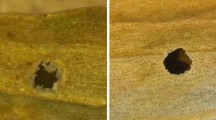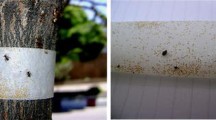Abstract
Sunn pest, Eurygaster integriceps Puton is a key pest of wheat and barley in Iran. In this study, the impact of site-specific spraying on control of sunn pest damage and densities of the natural enemies was compared with the whole-field spraying method in 2009 and 2010. Three plots were assigned to each spraying method and two others were left untreated as control. The plots were divided into 11 × 11 m grids. Adults of E. integriceps were sampled using the distance-walk method. Coccinellids, Chrysoperla carnea and nymphs of sunn pest were sampled using a sweep net. Spatial analysis of datasets was done using Geostatistical Analyst extension of ArcGIS 9.3. The spatial analysis indicated that the adults and nymphs of E. integriceps had aggregated distribution in space and that site-specific spraying was applicable. Whole-field spraying was carried out when the mean density of E. integriceps in plots exceeded the economic threshold. In the site-specific spraying method, decamethrin ([cyano-[3-(phenoxy) phenyl] methyl] 3-(2,2-dibromoethenyl)-2,2-dimethylcyclopropane-1-carboxylate) was applied to the grid cells with densities above the economic threshold. Site-specific application reduced the insecticide input by ca. 40–50%. The numbers of C. carnea and coccinellids were higher in site-specifically sprayed plots compared with whole-sprayed plots after treatment. The mean numbers of nymphs were not significantly different (P < 0.01) in whole-field and site-specifically sprayed plots. Percent damaged grain was below the economic damage threshold in all treated plots. It can be concluded that site-specific spraying has the potential to control E. integriceps at an acceptable level along with reducing the amount of insecticide used. It also conserved natural enemies in untreated refuges.













Similar content being viewed by others
References
Abdollahi, G. A. (2005). Sunn pest management in Iran: An analytical approach (in Persian). Tehran, Iran: Agricultural Education Publications. 242 pp.
Blom, P. E., Fleischer, S. J., & Smilowitz, Z. (2002). Spatial and temporal dynamics of Colorado potato beetle (Coleoptera: Chrysomelidae) in fields with perimeter and spatially targeted insecticides. Environmental Entomology, 31(1), 149–159.
Bressan, A., MoralGarcia, F. J., Semetey, O., & Boudon-Padieu, E. (2010). Spatio-temporal pattern of Pentastiridius leporinus migration in an ephemeral cropping system. Agricultural and Forest Entomology, 12(1), 59–68.
Clark, I. (2001). Practical geostatistics. On-line book: ISBN: 0-97033-17-03. www.uni-tuebingen.de/egpinfo/Pedometrie/PracticalGeostatistics1979.pdf (last accessed 18 Dec 2009).
Critchley, B. R. (1998). Literature review of sunn pest Eurygaster integriceps Put. (Hemiptera: Scutelleridae). Crop Protection, 17(4), 271–287.
Grego, C. R., Vieira, S. R., & Lourenção, A. L. (2006). Spatial distribution of Pseudaletia sequax Franclemlont in triticale under no-till management. Scientia Agricola, 63(4), 321–327.
Iranian Plant Protection Organization (IPPO). (2009). Report of countrywide control measures against sunn pest in 2008–2009 growing season (in Persian). Ministry of Agriculture Publications, Tehran, Iran. 33 pp.
Javahery, M. (1996). Sunn pest of wheat and barley in the Islamic Republic of Iran: Chemical and cultural methods of control. In R. H. Miller & J. G. Morse (Eds.), Sunn pests and their control in the Near East; FAO Plant Production and Protection Paper No. 138 (pp. 61–74). Rome, Italy: Food and Agriculture Organization of the United Nations.
Johnston, K., Ver Hoef, J. M., Krivoruchko, K., & Lucas, N. (2003). Using ArcGIS Geostatistical analyst. Redlands, CA: ESRI Press. 300 pp.
Krell, R. K., Pedigo, L. P., & Babcock, B. A. (2003). Comparison of estimated costs and benefits of site-specific versus uniform management for the bean leaf beetle in soybean. Precision Agriculture, 4(4), 401–411.
Liebhold, A. M., Rossi, R. E., & Kemp, W. P. (1993). Geostatistics and geographic information systems in applied insect ecology. Annual Review of Entomology, 38, 303–327.
Merrill, S. C., Holtzer, T. O., Peairs, F. B., & Lester, P. J. (2009). Modeling spatial variation of Russian wheat aphid overwintering population densities in Colorado winter wheat. Journal of Economic Entomology, 102(2), 533–541.
Midgarden, D., Fleischer, S. J., Weisz, R., & Smilowitz, Z. (1997). Site-specific integrated pest management impact on development of esfenvalerate resistance in Colorado potato beetle (Coleoptera: Chrysomelidae) and on densities of natural enemies. Journal of Economic Entomology, 90(4), 855–867.
Milliken, G., Willers, J., McCarter, K., & Jenkins, J. (2009). Designing experiments to evaluate the effectiveness of precision agricultural practices on research fields: Part 1 concepts for their formulation. Operational Research—An International Journal. doi:10.1007/s12351-009-0072-4.
Moral Garcia, F. J. (2006). Analysis of the spatio-temporal distribution of Helicoverpa armigera Hb. in a tomato field using a stochastic approach. Biosystems Engineering, 93(3), 253–259.
Muller, G., & Schwinn, F. J. (Eds.). (1992). Manual for field trials in plant protection (3rd ed.). Basle, Switzerland: CIBA-Geigy Ltd. 271 pp.
Nay, J. E., Park, Y.-L., & Perring, T. M. (2007). Effect of bunch sanitation on spatial distribution of abscised fruit and phycitine moths (Lepidoptera: Pyralidae) in California date gardens. Journal of Economic Entomology, 100(6), 1773–1780.
Park, Y.-L., Krell, R. K., & Carroll, M. (2007). Theory, technology, and practice of site-specific insect pest management. Journal of Asia-Pacific Entomology, 10(2), 89–101.
Park, Y.-L., & Tollefson, J. J. (2006). Development and economic evaluation of spatial sampling plans for corn rootworm Diabrotica spp. (Col., Chrysomelidae) adults. Journal of Applied Entomology, 130(6–7), 337–342.
Pedigo, L. P. (2004). Entomology and pest management (4th ed.). New Delhi, India: Prentice-Hall of India Pvt. Ltd.
Plant, R. E. (2001). Site-specific management: The application of information technology to crop production. Computers and Electronics in Agriculture, 30(1), 9–29.
Radjabi, Gh. (2000). Ecology of cereals’ sunn pests in Iran (in Persian). Tehran, Iran: Agricultural Education Publications. 163 pp.
Reisig, D., & Godfrey, L. (2006). Remote sensing for detection of cotton aphid (Homoptera: Aphididae) and spider mite (Acari: Tetranychidae) infested cotton in the San Joaquin Valley. Environmental Entomology, 35(6), 1635–1646.
Rezabeighi, M. (2005). Determining quantitative and qualitative damages of sunn pest in some regions of Iran. In G. A. Abdollahi (Ed.), Sunn pest management in Iran: An analytical approach (in Persian). Tehran, Iran: Agricultural Education Publications. 242 pp.
Saber, M., Hejazi, M. J., Kamali, K., & Moharramipour, S. (2005). Lethal and sublethal effects of fenitrothion and deltamethrin residues on the egg parasitoid Trissolcus grandis (Hymenoptera: Scelionidae). Journal of Economic Entomology, 98(1), 35–40.
SAS Institute Inc., SAS® 9.1. (2003). Qualification tools user’s guide. Cary, NC: SAS Institute Inc.
Sciarretta, A., Girma, M., Tikubet, G., Belayehun, L., Ballo, S., & Baumgartner, J. (2005). Development of an adaptive tsetse population management scheme for the Luke community, Ethiopia. Journal of Medical Entomology, 42(6), 1006–1019.
Sheikhi, A. (2005). Evaluating the effects of chemical control on sunn pest and other insect pests and natural enemies of wheat fields in eight provinces of Iran. In G. A. Abdollahi (Ed.), Sunn pest management in Iran: An analytical approach (in Persian). Tehran, Iran: Agricultural Education Publications. 242 pp.
Webster, R., & Oliver, M. A. (2001). Geostatistics for environmental scientists. New York: John Wiley & Sons, Ltd. 286 pp.
Weisz, R., Fleischer, S., & Smilowitz, Z. (1995). Site-specific integrated pest management for high value crops: Sample units for map generation using the Colorado potato beetle (Coleoptera: Chrysomelidae) as a model system. Journal of Economic Entomology, 88(5), 1069–1080.
Weisz, R., Fleischer, S., & Smilowitz, Z. (1996). Site-specific integrated pest management for high-value crops: Impact on potato pest management. Journal of Economic Entomology, 89(2), 501–509.
Willers, J. L., Jenkins, J. N., McKinion, J. M., Gerard, P., Hood, K. B., Bassie, J. R., et al. (2009). Methods of analysis for georeferenced sample counts of tarnished plant bugs in cotton. Precision Agriculture, 10(3), 189–212.
Willers, J. L., Milliken, G. A., Jenkins, J. N., O’Hara, C. G., Gerard, P. D., Reynolds, D. B., et al. (2008). Defining the experimental unit for the design and analysis of site-specific experiments in commercial cotton fields. Agricultural Systems, 96(1–3), 237–249.
Willers, J. L., Seal, M. R., & Luttrell, R. G. (1999). Remote Sensing, line-intercept sampling for tarnished plant bugs (Heteroptera: Miridae) in mid-south cotton. The Journal of Cotton Science, 3(4), 160–170.
Acknowledgments
Abbas Entezar Gharamaleki Director of the Plant Protection Bureau of East Azarbaijan Province kindly provided wheat fields for this study and his sincere help is gratefully acknowledged. The Board of Directors of Graduate Studies of the University of Tabriz provided financial support for this research and we are thankful for this help.
Author information
Authors and Affiliations
Corresponding author
Rights and permissions
About this article
Cite this article
Karimzadeh, R., Hejazi, M.J., Helali, H. et al. Assessing the impact of site-specific spraying on control of Eurygaster integriceps (Hemiptera: Scutelleridae) damage and natural enemies. Precision Agric 12, 576–593 (2011). https://doi.org/10.1007/s11119-010-9202-5
Published:
Issue Date:
DOI: https://doi.org/10.1007/s11119-010-9202-5




